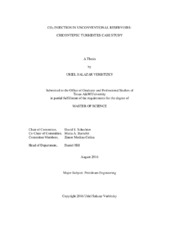| dc.description.abstract | New fracturing techniques have helped to unlock the once unrecoverable oil from unconventional reservoirs. Unfortunately, even with newer technologies, there are still resources in place that the industry is leaving behind mainly because there is a lack of understanding on how to efficiently exploit them. For example, while hydraulic fracturing may create the conduits for oil to flow, it may not be a readily applicable technology in a complex and highly heterogeneous media like the Chicontepec field in Mexico, and a need arises for EOR techniques to be studied.
This research focuses in simulating, history matching and analyzing a CO2 pilot test executed in the Chicontepec field. Fluid compositions, lab tests, and reservoir properties are provided based on a 40 x 40 x 40 grid. Also, pressure and production data are available for the wells.
First, a fluid model is created and tuned to match the lab tests. Then the reservoir model is completed and upscaled to improve CPU performance while avoiding loss of accuracy. The history match honors CO2 injection rates while retaining both pressure and rate control. Based on the best match, new scenarios are run to study the effect of different injection rates and volumes. Finally, dimensionless injection vs recovery curves are created based on simulation forecasting.
While the pilot test did not achieve the expected results, valuable insight was gained that will drive future projects. First, hydrocarbon pore volume injected (HCPVI) was too small to create a production response on off-set wells. Nevertheless, the extension of the hydraulic fracture on the injector well plays a key role in the early breakthrough observed in the one and only well in which CO2 breakthrough was observed. The geomechanical aspects of the fracture are not studied in detail but are proven to affect the numerical simulation. Finally, a few observations regarding the ideal data acquisition program are provided. | en |


